Origin Identification of Table Salt Using Flame Atomic Absorption and Portable Near-Infrared Spectrometries
Abstract
1. Introduction
2. Materials and Methods
2.1. Samples
2.2. Humidity Analysis
2.3. Flame Atomic Absorption/Emission Spectrometry Analysis
2.4. Near-Infrared Spectrometry Analysis
2.5. Data Analysis
3. Results and Discussion
3.1. Humidity
3.2. Flame Atomic Absorption/Emission Spectrometry
3.3. Near-Infrared Spectrometry
4. Conclusions
Supplementary Materials
Author Contributions
Funding
Data Availability Statement
Acknowledgments
Conflicts of Interest
References
- Kuhn, T.; Chytry, P.; Souza, G.M.S.; Bauer, D.V.; Amaral, L.; Dias, J.F. Signature of the Himalayan Salt. Nucl. Instrum. Methods. Phys. Res. B 2020, 477, 150–153. [Google Scholar] [CrossRef]
- Galvis-Sánchez, A.C.; Lopes, J.A.; Delgadillo, I.; Rangel, A.O.S.S. Fourier Transform Near-Infrared Spectroscopy Application for Sea Salt Quality Evaluation. J. Agric. Food Chem 2011, 59, 11109–11116. [Google Scholar] [CrossRef] [PubMed]
- Da-Col, J.A.; Bueno, M.I.M.S.; Melquiades, F.L. Fast and Direct Na and K Determination in Table, Marine, and Low-Sodium Salts by X-Ray Fluorescence and Chemometrics. J. Agric. Food Chem. 2015, 63, 2406–2412. [Google Scholar] [CrossRef] [PubMed]
- Galiga, H.F.; Sevilla, F.B. Smartphone-Based Optical Transduction for the Rapid Microscale Assessment of Iodate in Table Salt. Talanta 2021, 232, 122450. [Google Scholar] [CrossRef] [PubMed]
- Hassoun, A.; Siddiqui, S.A.; Smaoui, S.; Ucak, İ.; Arshad, R.N.; Bhat, Z.F.; Bhat, H.F.; Carpena, M.; Prieto, M.A.; Aït-Kaddour, A.; et al. Emerging Technological Advances in Improving the Safety of Muscle Foods: Framing in the Context of the Food Revolution 4.0. Food Rev. Int. 2024, 40, 37–78. [Google Scholar] [CrossRef]
- Soylak, M.; Murat, I. Determination of Copper, Cobalt, Lead, and Iron in Table Salt by FAAS After Separation Using Violuric Acid and Multiwalled Carbon Nanotubes. Food Anal. Methods 2012, 5, 1003–1009. [Google Scholar] [CrossRef]
- Gowen, A.A.; Marini, F.; Tsuchisaka, Y.; De Luca, S.; Bevilacqua, M.; O’Donnell, C.; Downey, G.; Tsenkova, R. On the Feasibility of near Infrared Spectroscopy to Detect Contaminants in Water Using Single Salt Solutions as Model Systems. Talanta 2015, 131, 609–618. [Google Scholar] [CrossRef] [PubMed]
- Fodor, M.; Matkovits, A.; Benes, E.L.; Jókai, Z. The Role of Near-Infrared Spectroscopy in Food Quality Assurance: A Review of the Past Two Decades. Foods 2024, 13, 3501. [Google Scholar] [CrossRef]
- Spoladore, S.F.; Brígida dos Santos Scholz, M.; Bona, E. Genotypic Classification of Wheat Using Near-Infrared Spectroscopy and PLS-DA. Appl. Food Res. 2021, 1, 100019. [Google Scholar] [CrossRef]
- Francielli Vieira, T.; Makimori, G.Y.; Scholz, M.B.; Zielinski, A.; Bona, E. Chemometric Approach Using ComDim and PLS-DA for Discrimination and Classification of Commercial Yerba Mate (Ilex paraguariensis St. Hil.). Food Anal. Methods 2020, 13, 97–107. [Google Scholar] [CrossRef]
- de Andrade, J.C.; Galvan, D.; Effting, L.; Lelis, C.; Melquiades, F.L.; Bona, E.; Conte-Junior, C.A. An Easy-to-Use and Cheap Analytical Approach Based on NIR and Chemometrics for Tomato and Sweet Pepper Authentication by Non-Volatile Profile. Food Anal. Methods 2023, 16, 567–580. [Google Scholar] [CrossRef]
- Galvan, D.; Lelis, C.A.; Effting, L.; Melquiades, F.L.; Bona, E.; Conte-Junior, C.A. Low-Cost Spectroscopic Devices with Multivariate Analysis Applied to Milk Authenticity. Microchem. J. 2022, 181, 107746. [Google Scholar] [CrossRef]
- Frost, V.J.; Molt, K. Analysis of Aqueous Solutions by Near-Infrared Spectrometry (NIRS) III. Binary Mixtures of Inorganic Salts in Water. J. Mol. Struct. 1997, 410–411, 573–579. [Google Scholar] [CrossRef]
- Pasquini, C. Near Infrared Spectroscopy: A Mature Analytical Technique with New Perspectives—A Review. Anal. Chim. Acta 2018, 1026, 8–36. [Google Scholar] [CrossRef] [PubMed]
- Março, P.; Bona, E.; Valderrama, P. Chapter 4—Chemometrics Applied to Food Control. In Food Control and Biosecurity; Academic Press: Cambridge, MA, USA, 2018. [Google Scholar]
- Galvan, D.; Aquino, A.; Effting, L.; Mantovani, A.C.G.; Bona, E.; Conte-Junior, C.A. E-Sensing and Nanoscale-Sensing Devices Associated with Data Processing Algorithms Applied to Food Quality Control: A Systematic Review. Crit. Rev. Food Sci. Nutr. 2022, 62, 6605–6645. [Google Scholar] [CrossRef] [PubMed]
- Granato, D.; Putnik, P.; Kovačević, D.B.; Santos, J.S.; Calado, V.; Rocha, R.S.; Da Cruz, A.G.; Jarvis, B.; Rodionova, O.Y.; Pomerantsev, A. Trends in Chemometrics: Food Authentication, Microbiology, and Effects of Processing. Compr. Rev. Food Sci. Food Saf. 2018, 17, 663–677. [Google Scholar] [CrossRef] [PubMed]
- Rodionova, O.Y.; Titova, A.V.; Pomerantsev, A.L. Discriminant Analysis Is an Inappropriate Method of Authentication. TrAC Trends Anal. Chem. 2016, 78, 17–22. [Google Scholar] [CrossRef]
- Zontov, Y.V.; Rodionova, O.Y.; Kucheryavskiy, S.V.; Pomerantsev, A.L. DD-SIMCA—A MATLAB GUI Tool for Data Driven SIMCA Approach. Chemom. Intell. Lab. Syst. 2017, 167, 23–28. [Google Scholar] [CrossRef]
- Pomerantsev, A.L.; Rodionova, O.Y. Concept and Role of Extreme Objects in PCA/SIMCA. J. Chemom 2014, 28, 429–438. [Google Scholar] [CrossRef]
- Instituto Adolfo Lutz. Métodos Físico-Químicos Para Análise de Alimentos; Zenebon, O., Pascuet, N.S., Tiglea, P., Eds.; Instituto Adolfo Lutz: Sao Paulo, Brazil, 2008.
- Kucheryavskiy, S.; Rodionova, O.; Pomerantsev, A. A Comprehensive Tutorial on Data-Driven SIMCA: Theory and Implementation in Web. J. Chemom. 2024, 38, e3556. [Google Scholar] [CrossRef]
- Burns, D.A.; Ciurczak, E.W. Handbook of Near-Infrared Analysis, 3rd ed.; CRC Press: Boca Raton, FL, USA, 2007; ISBN 9780429123016. [Google Scholar]
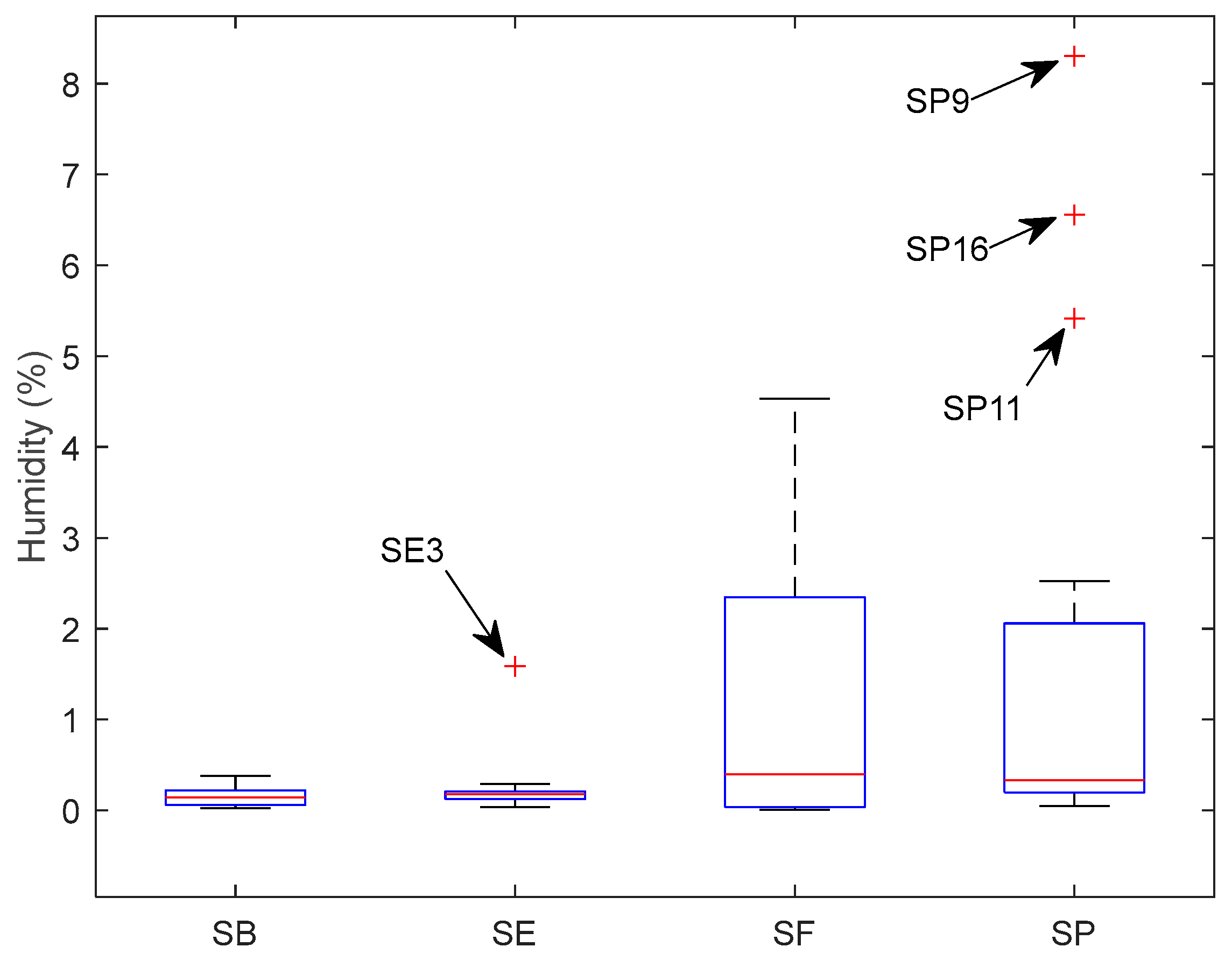
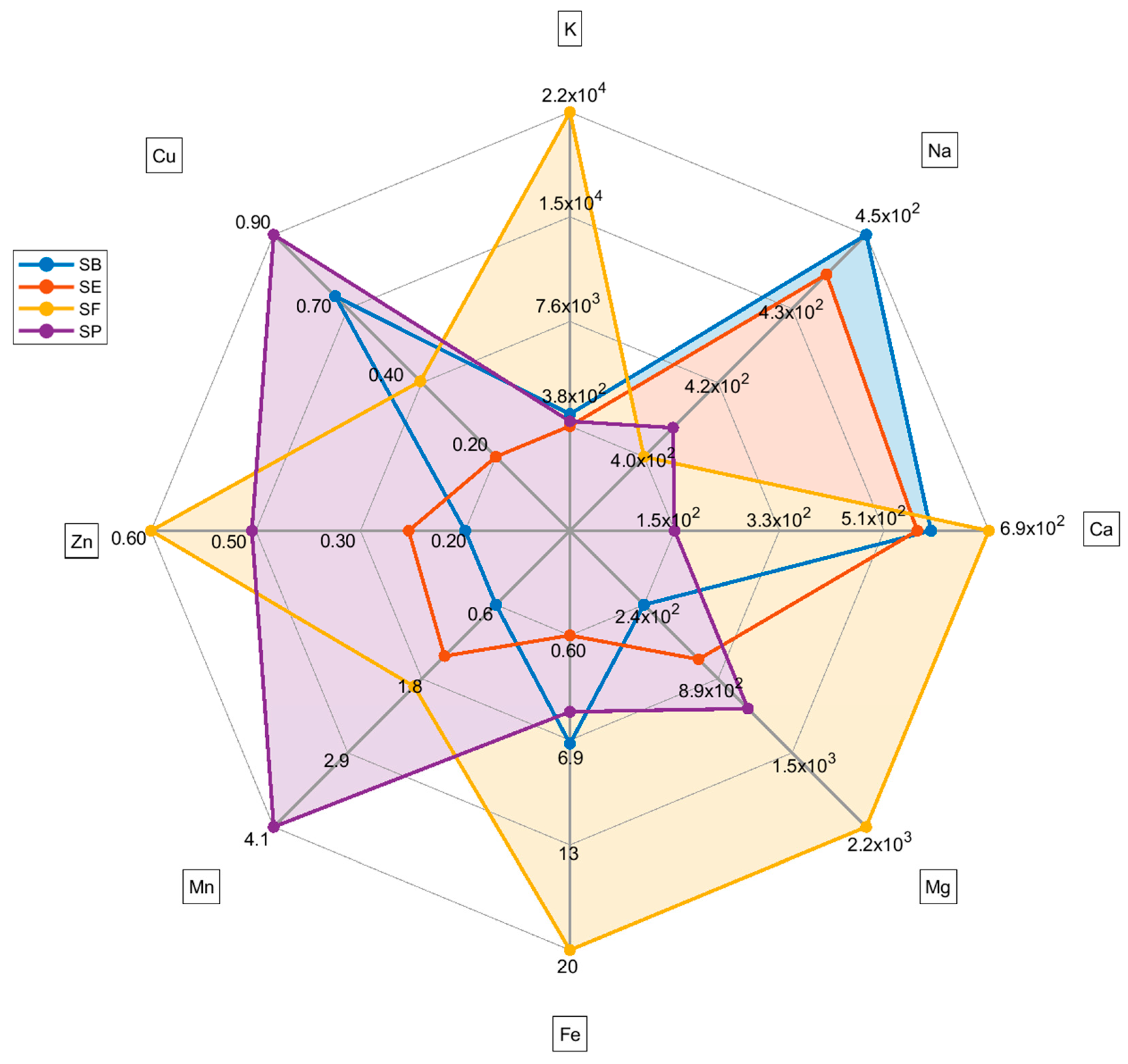
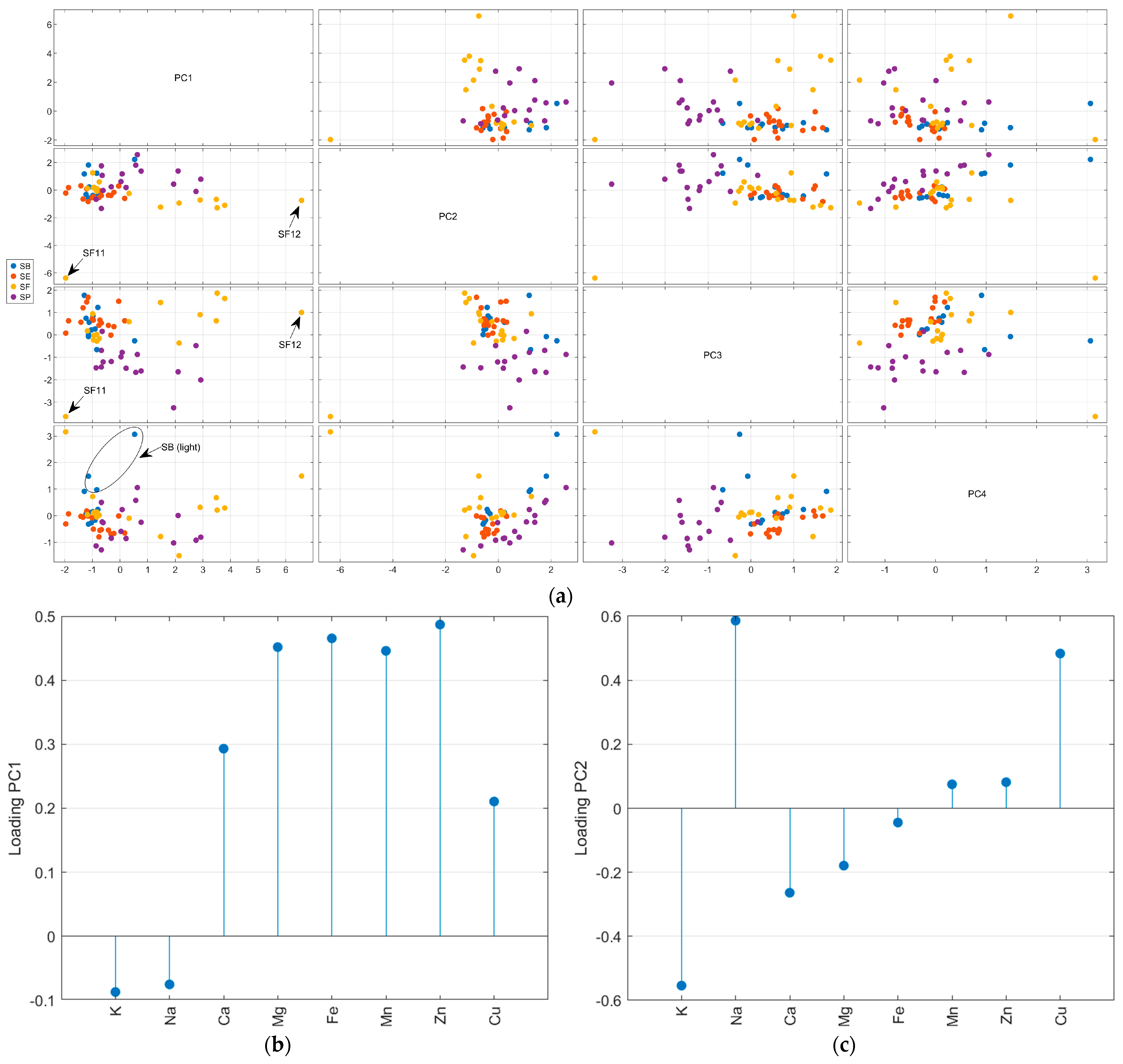
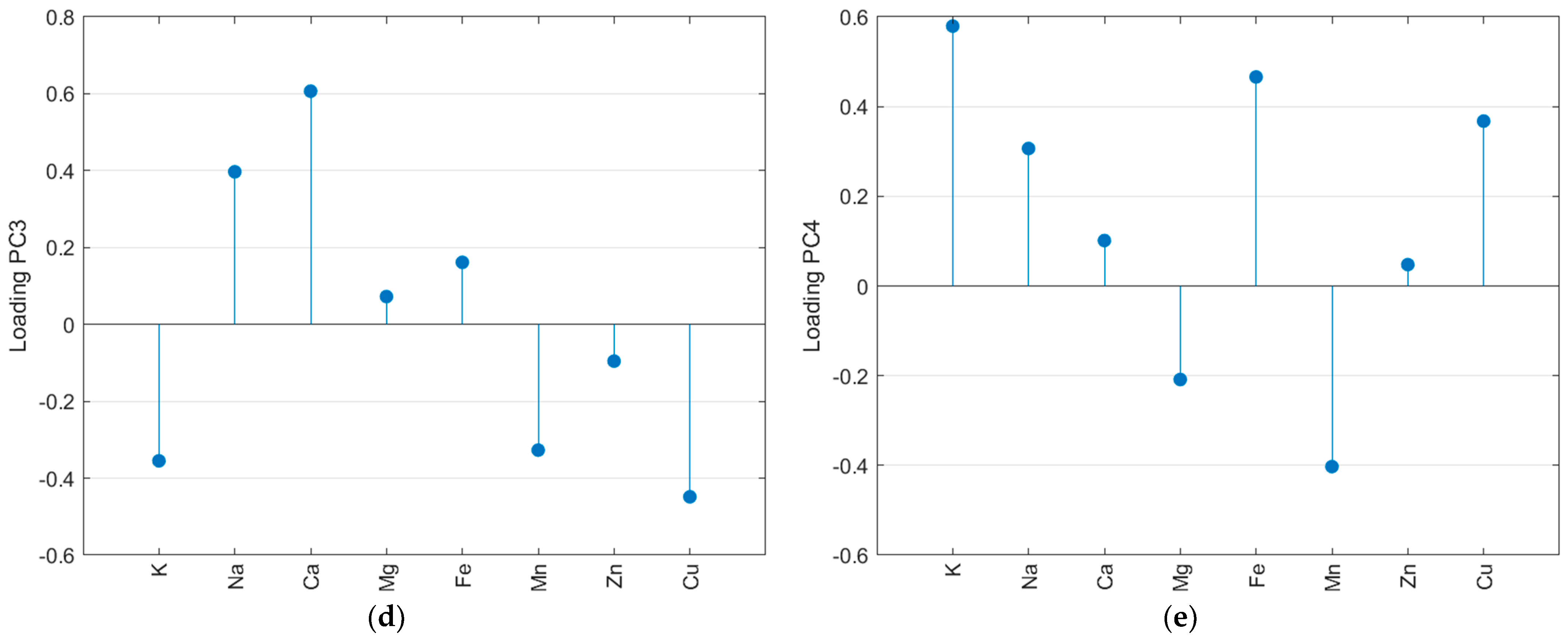

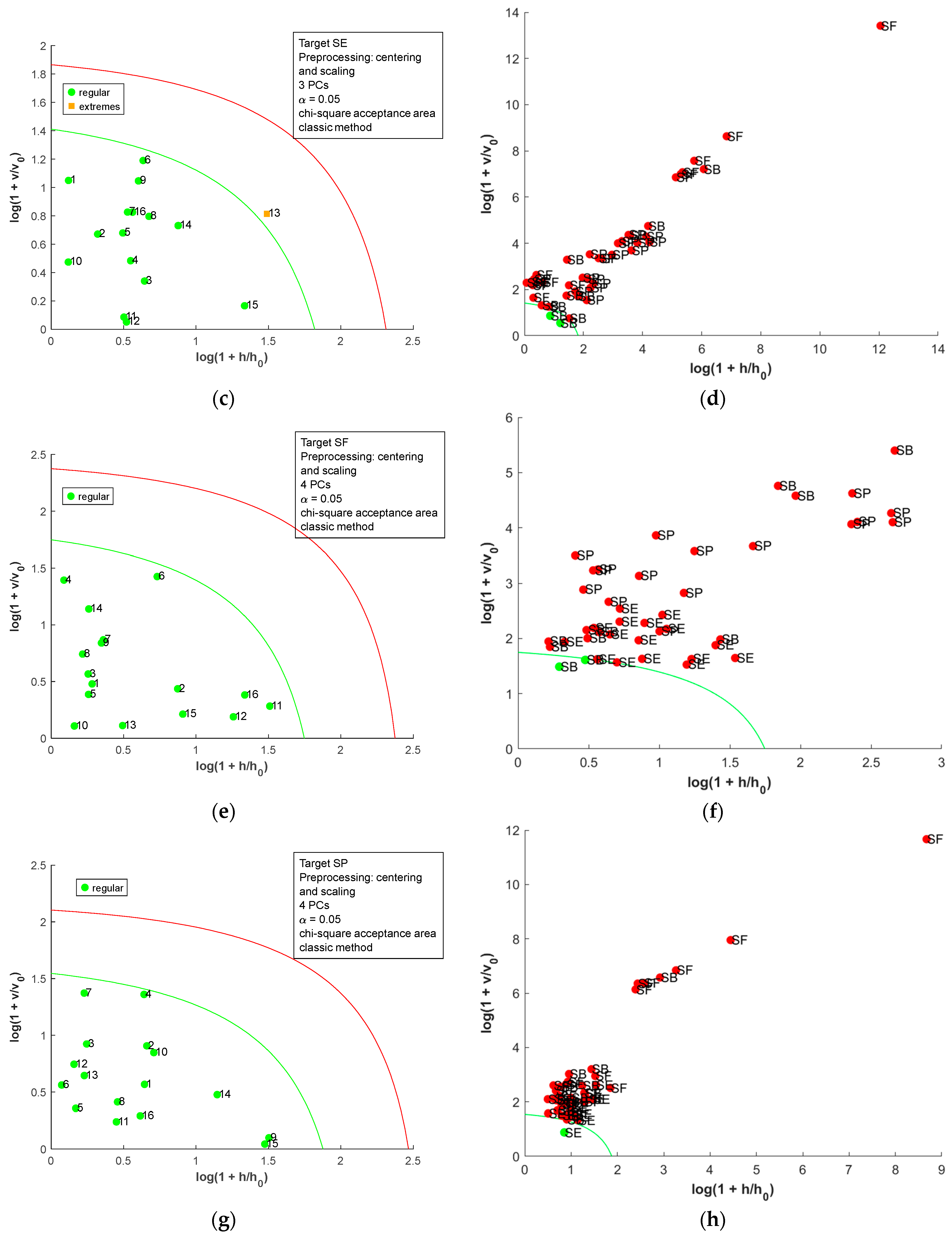

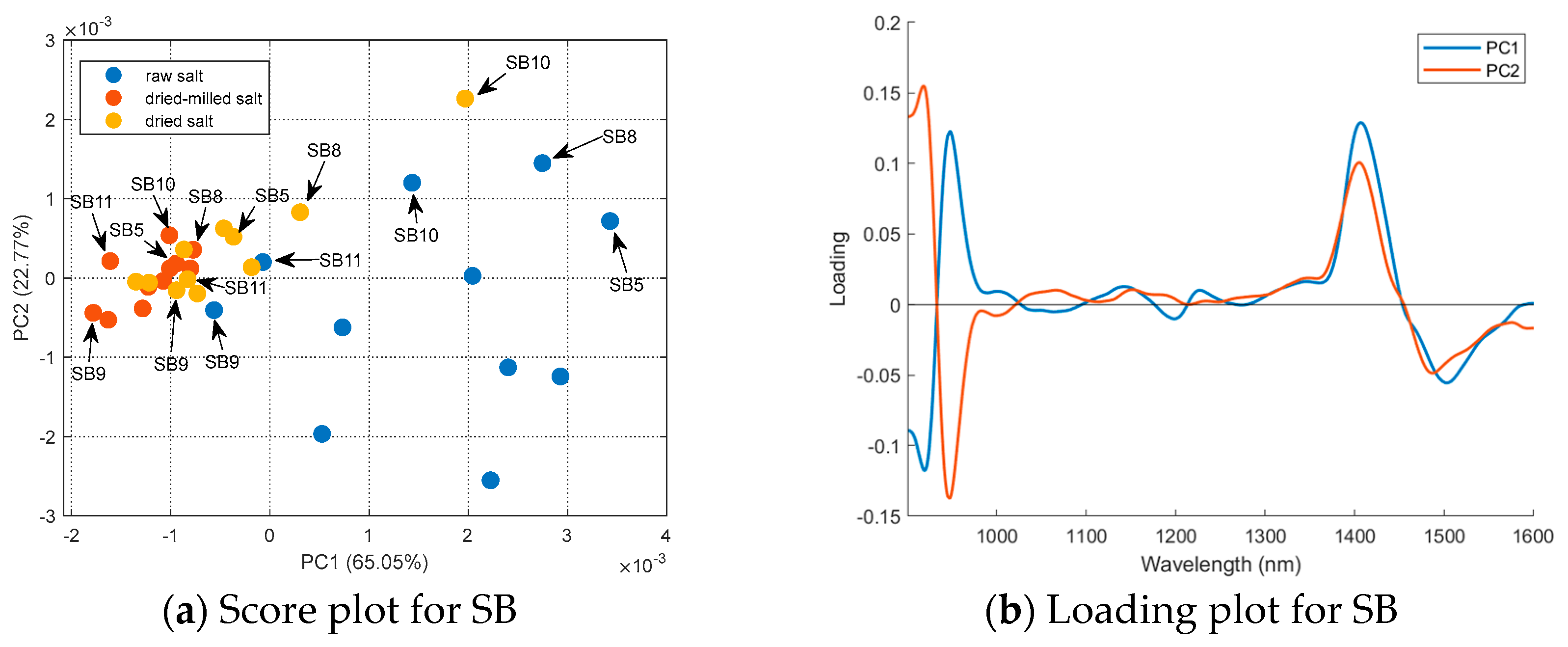
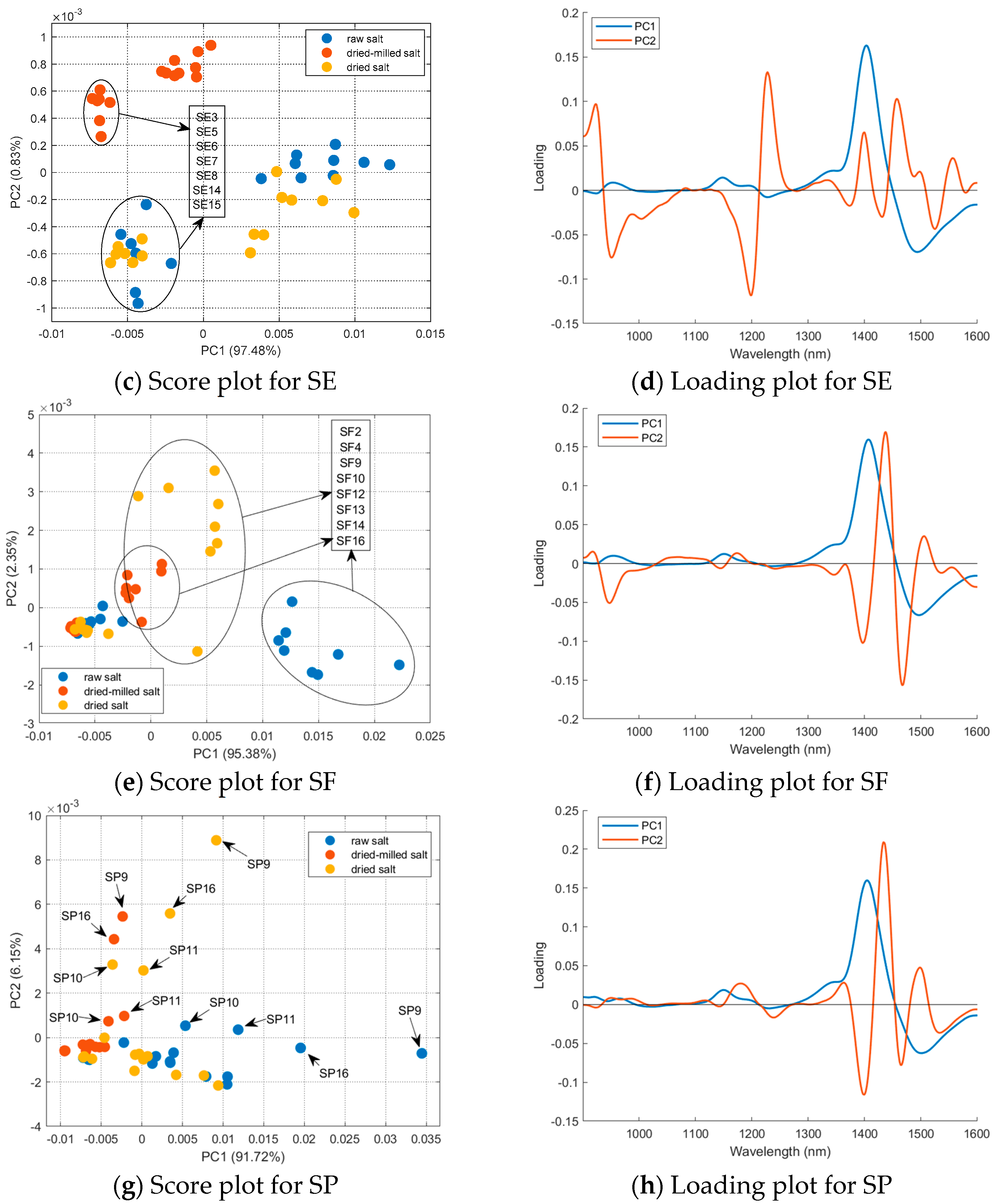

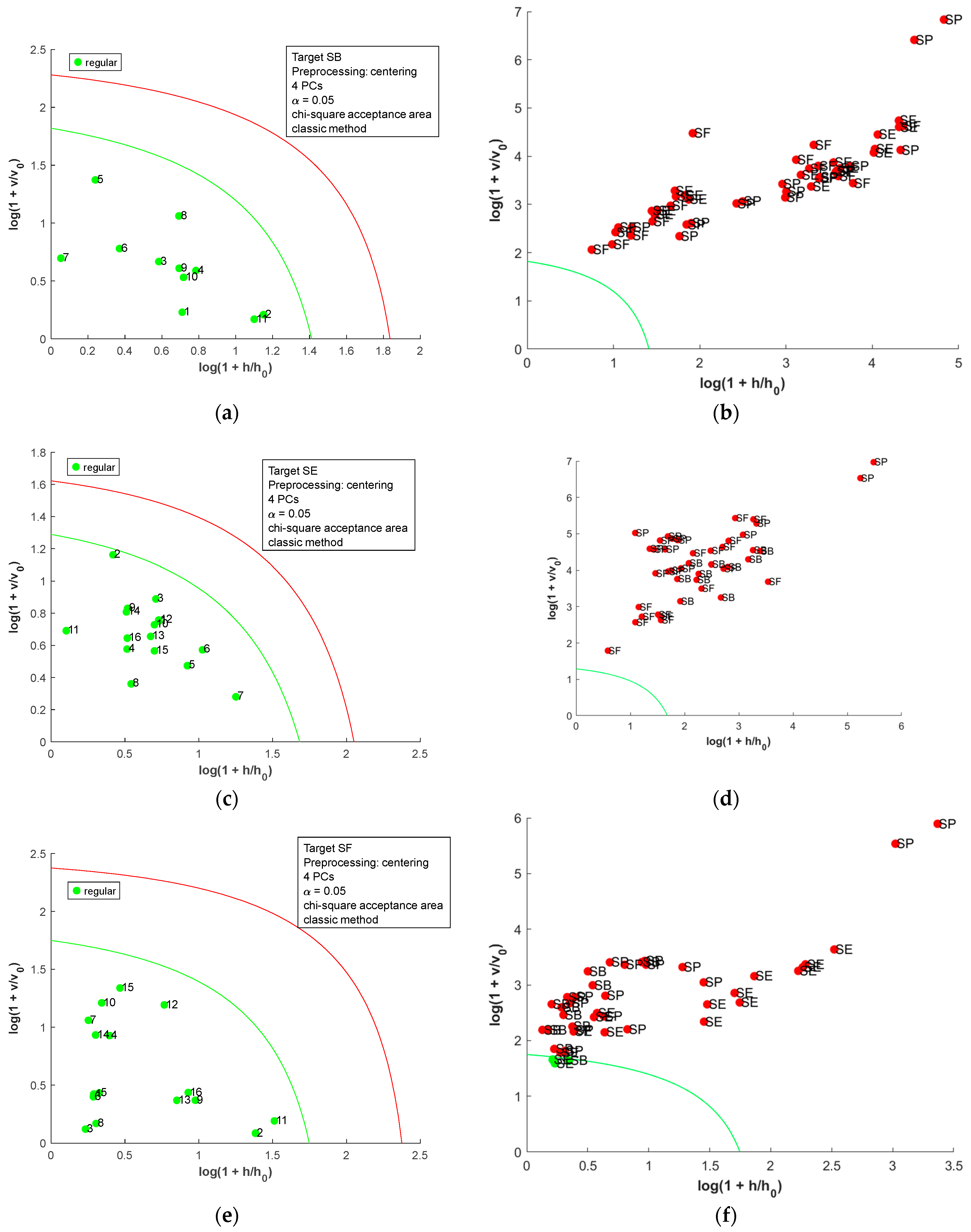
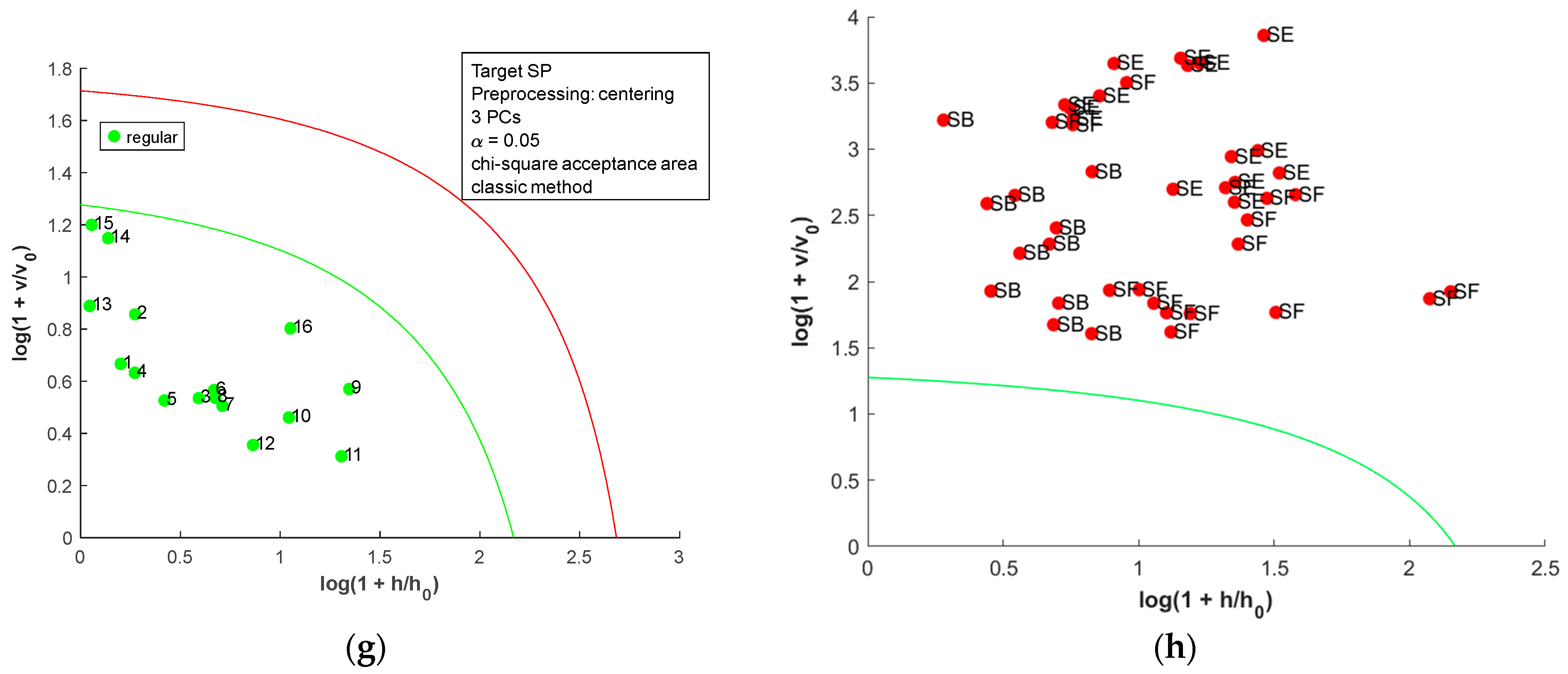
| Country | Minimum | Maximum | Median * | Mean ** | Standard Deviation |
|---|---|---|---|---|---|
| K (µg g−1) | |||||
| SB | 169 | 4.22 × 103 | 251 a | 1.21 × 103 a | 1.66 × 103 |
| SE | 126 | 1.23 × 103 | 356 a | 379 a | 242 |
| SF | 36.9 | 3.42 × 105 | 770 a | 2.20 × 104 a | 8.54 × 104 |
| SP | 65.0 | 4.03 × 103 | 296 a | 711 a | 1.04 × 103 |
| Na (mg g−1) | |||||
| SB | 341 | 648 | 421 ab | 451 a | 94.7 |
| SE | 382 | 557 | 418 b | 441 a | 51.3 |
| SF | 134 | 601 | 400 a | 398 a | 89.9 |
| SP | 177 | 606 | 415 ab | 404 a | 121 |
| Ca (µg g−1) | |||||
| SB | 347 | 1.05 × 103 | 540 b | 593 b | 203 |
| SE | 97.2 | 1.08 × 103 | 610 b | 569 b | 274 |
| SF | 113 | 1.81 × 103 | 355 b | 692 b | 596 |
| SP | 0.622 | 1.23 × 103 | 77.7 a | 154 a | 299 |
| Mg (µg g−1) | |||||
| SB | 77.9 | 635 | 132 a | 236 a | 174 |
| SE | 35.2 | 1.45 × 103 | 867 b | 719 a | 530 |
| SF | 21.8 | 7.28 × 103 | 1.61 × 103 ab | 2.20 × 103 b | 2.37 × 103 |
| SP | 4.17 | 6.06 × 103 | 580 b | 1.16 × 103 ab | 1.56 × 103 |
| Fe (µg g−1) | |||||
| SB | 0.286 | 53.3 | 1.80 b | 7.09 ab | 15.4 |
| SE | 0.027 | 2.34 | 0.127 a | 0.579 a | 0.854 |
| SF | 0.0187 | 105 | 0.869 abc | 19.5 b | 31.6 |
| SP | 1.70 | 8.79 | 5.09 c | 5.17 ab | 2.01 |
| Mn (µg g−1) | |||||
| SB | 0.111 | 1.11 | 0.545 a | 0.616 a | 0.327 |
| SE | 0.0126 | 2.69 | 1.86 b | 1.42 a | 1.00 |
| SF | 0.0111 | 6.55 | 1.16 ab | 1.89 a | 1.95 |
| SP | 1.52 | 7.08 | 3.81 c | 4.08 b | 1.58 |
| Zn (µg g−1) | |||||
| SB | 0.103 | 0.270 | 0.192 a | 0.193 a | 0.0480 |
| SE | 0.00893 | 0.601 | 0.229 a | 0.267 a | 0.152 |
| SF | 0.208 | 1.20 | 0.562 b | 0.602 b | 0.227 |
| SP | 0.0790 | 0.853 | 0.506 b | 0.471 b | 0.242 |
| Cu (µg g−1) | |||||
| SB | 0.357 | 1.93 | 0.445 bc | 0.737 bc | 0.564 |
| SE | 0.0663 | 0.425 | 0.196 a | 0.186 a | 0.0941 |
| SF | 0.125 | 0.775 | 0.444 b | 0.445 ab | 0.136 |
| SP | 0.266 | 1.54 | 0.942 c | 0.948 c | 0.383 |
| Metal | PC1 | PC2 |
|---|---|---|
| K | −0.1230 | 0.0572 |
| Na | −0.1350 | −0.0019 |
| Ca | −0.3409 * | −0.0396 |
| Mg | 0.7503 * | 0.2969 * |
| Fe | 0.2214 | 0.0444 |
| Mn | 0.6573 * | 0.2701 * |
| Zn | 0.3896 * | 0.2155 |
| Cu | 0.0582 | 0.4787 * |
Disclaimer/Publisher’s Note: The statements, opinions and data contained in all publications are solely those of the individual author(s) and contributor(s) and not of MDPI and/or the editor(s). MDPI and/or the editor(s) disclaim responsibility for any injury to people or property resulting from any ideas, methods, instructions or products referred to in the content. |
© 2025 by the authors. Licensee MDPI, Basel, Switzerland. This article is an open access article distributed under the terms and conditions of the Creative Commons Attribution (CC BY) license (https://creativecommons.org/licenses/by/4.0/).
Share and Cite
Zanela Lima, L.R.; Santos, L.D.d.; Taglieri, I.; Cabral, D.; Estevinho, L.; Melquiades, F.L.; Dias, L.G.; Bona, E. Origin Identification of Table Salt Using Flame Atomic Absorption and Portable Near-Infrared Spectrometries. Chemosensors 2025, 13, 231. https://doi.org/10.3390/chemosensors13070231
Zanela Lima LR, Santos LDd, Taglieri I, Cabral D, Estevinho L, Melquiades FL, Dias LG, Bona E. Origin Identification of Table Salt Using Flame Atomic Absorption and Portable Near-Infrared Spectrometries. Chemosensors. 2025; 13(7):231. https://doi.org/10.3390/chemosensors13070231
Chicago/Turabian StyleZanela Lima, Larissa Rodrigues, Luana Dalagrana dos Santos, Isabella Taglieri, David Cabral, Letícia Estevinho, Fábio Luiz Melquiades, Luís Guimarães Dias, and Evandro Bona. 2025. "Origin Identification of Table Salt Using Flame Atomic Absorption and Portable Near-Infrared Spectrometries" Chemosensors 13, no. 7: 231. https://doi.org/10.3390/chemosensors13070231
APA StyleZanela Lima, L. R., Santos, L. D. d., Taglieri, I., Cabral, D., Estevinho, L., Melquiades, F. L., Dias, L. G., & Bona, E. (2025). Origin Identification of Table Salt Using Flame Atomic Absorption and Portable Near-Infrared Spectrometries. Chemosensors, 13(7), 231. https://doi.org/10.3390/chemosensors13070231








